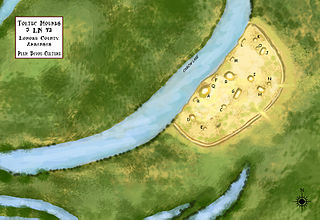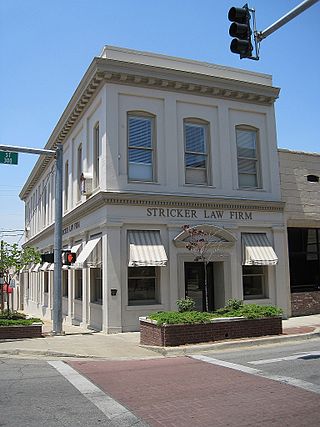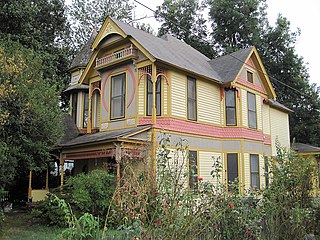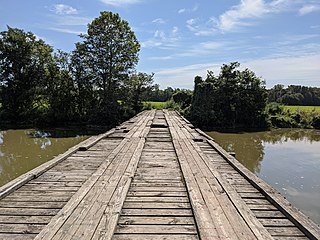Related Research Articles

Craighead County is a county located in the U.S. state of Arkansas. As of the 2020 census, the population was 111,231. The county has two county seats — Jonesboro and Lake City. Craighead County is Arkansas's 58th county, formed on February 19, 1859, and named for state Senator Thomas Craighead. It is one of several dry counties within the state of Arkansas, in which the sale of alcoholic beverages is largely prohibited.

Jonesboro is a city located on Crowley's Ridge in the northeastern corner of the U.S. State of Arkansas. Jonesboro is one of two county seats of Craighead County. In 2023, the city had a population of 81,969 and was the fifth-largest city in Arkansas at the time. In 2023, the Jonesboro metropolitan area had a population of 135,287 and a population of 179,932 in the Jonesboro-Paragould Combined Statistical Area.

Highway 463 is a north–south state highway in northeast Arkansas. The route of 20.59 miles (33.14 km) runs from Highway 14 very near I-555 at Payneway north to I-555/US 63B in Jonesboro. The route is a redesignation of former U.S. Route 63, which has since been rerouted onto US 49.

The Menard–Hodges site (3AR4), is an archaeological site in Arkansas County, Arkansas. It includes two large platform mounds as well as several house mounds. It is the type site for the Menard phase, a protohistoric Mississippian culture group.

Plum Bayou Mounds Archeological State Park, formerly known as "Toltec Mounds Archeological State Park", also known as Knapp Mounds, Toltec Mounds or Toltec Mounds site, is an archaeological site from the Late Woodland period in Arkansas that protects an 18-mound complex with the tallest surviving prehistoric mounds in Arkansas. The site is on the banks of Mound Lake, an oxbow lake of the Arkansas River. It was occupied by its original inhabitants from the 7th to the 11th century. The site is designated as a National Historic Landmark.

This is a list of the National Register of Historic Places listings in Craighead County, Arkansas.

This is a list of the National Register of Historic Places listings in Hempstead County, Arkansas.

This is a list of the National Register of Historic Places listings in Mississippi County, Arkansas.

Twelve special routes of U.S. Route 63 currently exist. Arkansas and Missouri each contain five, with two in Iowa. There are also five former routings that have been removed from the system.

The Wright-Patterson Air Force Base Mound, designated 33GR31, is a Native American mound near the city of Dayton in Greene County, Ohio, United States. Named for its location on an Air Force facility, Wright-Patterson Air Force Base, the mound is an archaeological site.

The Mercantile Bank Building is a historic bank building at 249 South Main Street in Jonesboro, Arkansas. The brick building was built in 1890 for Craighead County Bank. The bank used the building until 1894. It was then used as a clothing store and for offices afterwards until 1901 when it was occupied by Jonesboro Savings & Trust,. The architectural firm of Hoggson Brothers conducted a 1919 update and remodel of the building. Jonesboro bank closed in 1931 and, after fundraising efforts to open a new bank in the town, Mercantile Bank opened in the building in 1932. Mercantile moved its bank in 1969 and Crowley's Ridge Development Council used the building until 2004.
The Hughes Mound Site, (3SA11), is an archeological site in Saline County, Arkansas near Benton. The 4.5-acre (1.8 ha) is an important Caddoan Mississippian culture village center, at the northeastern frontier of that civilization. It is the only known platform mound site south of Benton on the Saline River. The site has not been dated, but artifacts found there are consistent with the Caddoan period; no contact-period artifacts have been found.

Boone's Mounds are a ceremonial site of the Coles Creek culture located in Calhoun County, Arkansas. The site is one of the largest mound sites in the Ouachita River valley. Archeological excavation at the site has yielded dates of occupation as early as 600 AD, and it may still have been in use during the early contact period, c. 1700. The site was located on private property at the time of its listing on the National Register of Historic Places in 1980.
The Ross Site designated 3CL401, is a prehistoric archaeological site in Clark County, Arkansas, near the small town of Whelen Springs. The site includes two Native American mounds from the Caddoan culture, which have been dated to AD 1400–1600. It is one of a small number of Caddoan sites in southwestern Arkansas. The site was relatively unscathed until the mid-1980s, having never been plowed over, thus leaving intact potential ground-level features other than the mounds.

The Bell House is a historic house at 303 West Cherry Street in Jonesboro, Arkansas. It is a two-story wood-frame structure, built in 1895 by J. V. Bell, owner of one of Jonesboro's first bookstores. The house is an elaborately-decorated Queen Anne Victorian, with an asymmetrical arrangement of projecting bays, gables, and porches. The front porch has a delicate spindle-work frieze, and is supported by turned columns. Different types of cut shingles give variety to the wall surfaces.

The Chickasawba Mound, designated by the Smithsonian trinomial 3M55, is an archaeological site in Blytheville, Arkansas. It encompasses the remains of a modest Nodena phase town, with a ceremonial mound and evidence of occupation during the 16th century. The site is one of the best-preserved Nodena sites in the region. The site was listed on the National Register of Historic Places in 1984. The site derives its name from Chickasawba, a chief of the Shawnee tribe, said to have been buried at the foot of the mound.

The Craighead County Courthouse is located at 511 Main Street, in the center of Jonesboro, Arkansas, the county seat of Craighead County. It is a two-story brick structure with limestone trim, built in 1934, and is the city's only significant example of Art Deco architecture. The building has a stepped appearance, with a large central block that has an oversized second story, and is flanked by smaller two-story wings, from which single-story sections project to the front and back. Vertical panels of fluted limestone accentuate corner projections from the main block, a motif repeated near the roof line of that block. The main entrance is recessed in an opening flanked by similarly fluted panels. The courthouse is the fifth of the county to stand on the site. Near the entrance to the courthouse stands a copy of John Paulding's World War I memorial, Over the Top, placed in 1920, and often confused with E. M. Viquesney's "Spirit of the American Doughboy".

The Craighead County Road 513C Bridge is a historic bridge in rural northeastern Craighead County, Arkansas. It carries County Road 513C, a short stub leading east from the junction of County Roads 513 and 998, across an unnamed ditch. It is a steel deck truss bridge whose main span 76 feet (23 m) long, mounted on wooden piers. Combined with its approaches, the bridge is 142 feet (43 m) long. Its deck is made of timber overlaying steel. The bridge is a World War II-era structure, built in 1942.
The Nash-Reid-Hill House is a historic house at 418 West Matthews Avenue in Jonesboro, Arkansas. It is a 2+1⁄2-story wood-frame house, faced in brick veneer, with a hipped roof that has multiple cross gables and a three-story tower with a conical roof. The house was built between 1898 and 1902, using locally fired brick, and is a locally notable example of Queen Anne architecture, although its porch was modified in 1934 to give it a more French Eclectic appearance. It is also notable for its association with the locally prominent Nash family, who have long been prominent businessmen and landowners in the years since the American Civil War.

The St. Francis River Bridge, also known as the Lake City Bridge, was a historic bridge spanning the St. Francis River at Lake City, Arkansas. It was composed of 109 I-beam trestles and a single vertical lift span, and had a total length of 3,412 feet (1,040 m). The bridge was designed and built in 1934 by the Vincennes Bridge Company, and carried Arkansas Highway 18 until 1998, when a modern 4-span I-beam bridge was built adjacent to it. The old bridge was dismantled, leaving only the vertical lift segment on the east bank of the river.
References
- 1 2 "National Register Information System". National Register of Historic Places . National Park Service. July 9, 2010.
- ↑ "Summary description of Bay Mounds". Arkansas Preservation. Archived from the original on November 26, 2014. Retrieved November 26, 2014.